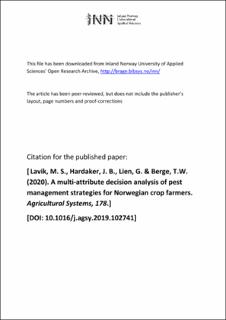A multi-attribute decision analysis of pest management strategies for Norwegian crop farmers
Abstract
This study provides a multi-attribute approach to support decisions by Norwegian crop farmers considering adopting innovative crop protection measures. In modelling choice among pest management strategies, we have accounted for both economic risks, risks to human health and risks to the environment. We used the Simple Multi-Attribute Rating Technique (SMART) to evaluate the results of a field trial comparing four different pest management strategies. In the trial, various pre-crops in year one were followed by two consecutive years of winter wheat. Two treatments had different levels of integrated pest management (IPM). IPM1 was the most innovative treatment and used less pesticides (i.e. herbicides, insecticides and fungicides) than IPM2. The third treatment (‘Worst Case’, WC) used pesticides routinely. The fourth treatment (‘No Plant Protection’, NPP) used no plant protection measures except one reduced dose of herbicide per year on winter wheat. Two main attributes were included in the SMART analysis, an economic indicator and a pesticide load indicator, each of which comprised a number of attributes at a subsidiary level. The results showed that the IPM1 and NPP strategies performed better than IPM2 and the WC strategies. However, the ranking of the pest management practices depended on the weighting of the two main attributes. Although the SMART analysis gave ordinal utility values, permitting only ranking of the alternatives, we were able to transform the results to measure financial differences between the alternatives.
Description
© 2019 Elsevier Ltd. All rights reserved. Dette er den aksepterte versjonen av en artikkel publisert i Agricultural Systems. Du finner den publiserte artikkelen her: https://doi.org/10.1016/j.agsy.2019.102741 // This is the postprint version of the article published in Agricultural Systems. You can find the published article here: https://doi.org/10.1016/j.agsy.2019.102741

